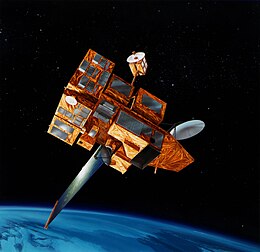ADEOS 2

Illustration of ADEOS II
|
|||||||||||||
| Names | Advanced Earth Observing Satellite II Midori II |
||||||||||||
|---|---|---|---|---|---|---|---|---|---|---|---|---|---|
| Mission type | Earth observation Environmental monitoring |
||||||||||||
| Operator | NASDA / NASA / CNES | ||||||||||||
| COSPAR ID | 2002-056A | ||||||||||||
| SATCAT no. | 27597 | ||||||||||||
| Mission duration | Final: 10 months, 9 days | ||||||||||||
| Spacecraft properties | |||||||||||||
| Manufacturer | Mitsubishi Electric | ||||||||||||
| Launch mass | 3,680 kg (8,110 lb) | ||||||||||||
| Dimensions | 4 × 4 × 5 m (13 × 13 × 16 ft) | ||||||||||||
| Power | 5,000 watts | ||||||||||||
| Start of mission | |||||||||||||
| Launch date | 14 December 2002, 01:31 UTC | ||||||||||||
| Rocket | H-IIA 202 | ||||||||||||
| Launch site | Tanegashima Yoshinobu 1 | ||||||||||||
| End of mission | |||||||||||||
| Disposal | Spacecraft failure | ||||||||||||
| Last contact | 23 October 2003, 23:55 UTC | ||||||||||||
| Orbital parameters | |||||||||||||
| Reference system | Geocentric | ||||||||||||
| Regime | Sun-synchronous | ||||||||||||
| Eccentricity | 0.0002068 | ||||||||||||
| Perigee | 799 km (496 mi) | ||||||||||||
| Apogee | 802 km (498 mi) | ||||||||||||
| Inclination | 98.3466° | ||||||||||||
| Mean motion | 14.27 rev/day | ||||||||||||
| Epoch | 27 December 2016 23:58:05 UTC | ||||||||||||
|
|||||||||||||
| Instruments | |
|---|---|
| AMSR | Advanced Microwave Scanning Radiometer |
| GLI | Global Imager |
| SeaWinds | |
| ILAS-2 | Improved Limb Atmospheric Spectrometer 2 |
| POLDER | Polarization and Directionality of Earth's Reflectances |
ADEOS II (Advanced Earth Observing Satellite 2) was an Earth observation satellite launched by NASDA, NASA and CNES in December 2002. Its Japanese name was Midori 2, and it was the successor to the 1996 mission ADEOS I. The mission ended in October 2003 after the satellite's solar panels failed.
The three primary objectives of the mission, as identified by NASDA, were to:
The project had a proposed minimum life of three years, with a five-year goal.
The mission was originally scheduled to launch aboard a H-II rocket in February 2002. This was postponed as the Japanese Space Activities Commission would not launch without having three successful missions aboard the new H-IIA rocket.
The satellite was successfully launched from Tanegashima Space Center pad YLP-1 on 14 December 2002, aboard H-2A-202. Other payloads onboard included the Japanese MicroLabsat and WEOS devices, as well as the Australian FedSat.
On 23 October 2003, the solar panel failed. At 2349 UTC, the satellite switched to "light load" operation due to an unknown error. This was intended to power down all observation equipment to conserve energy. At 2355 UTC, communications between the satellite and the ground stations ended, with no further telemetry received. Further attempts to procure telemetry data on 24 October (at 0025 and 0205 UTC) also failed.
After the power failure, JAXA (NASDA's successor) formed the Midori II anomaly investigation team. Analysis of data received before transmissions ceased showed that the solar panel's power output had decreased from 6 kW to 1 kW. The investigation team began surveying the mission to establish whether the failure was due to a technical malfunction or a solar flare.
...
Wikipedia
